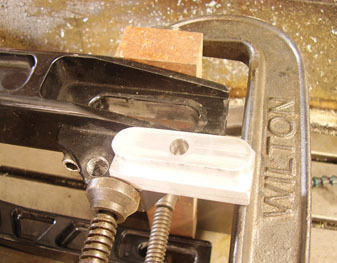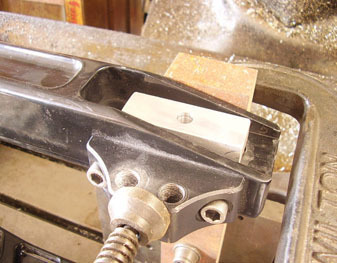Over the years I have done a huge amount of custom machine work for custom Harley motorcycles. You see, I am an old motorhead and I understand the addiction some people have for horsepower. This month’s article explains how to put an oversize rear axle in a Harley to deal with a ridiculous amount of power.
This particular bike came with an engine capable of 60 horsepower. The biker who owned it was not satisfied, and so he had an engine built with double the horsepower — 120 hp. That’s great, but the stock 3/4" axle couldn’t take it. Breaking parts, of course, is a common thing for horsepower junkies. The 3/4" axle got bent.
The wrench who built the big motor got in touch with me to replace the bent axle with a 1" axle. Figure 1 shows the new axle setup beside the bent part. The 1" diameter makes the new axle 1.8 times stronger because the strength is related to the cross-sectional area of the axle, not the diameter. So, if the axle was doubled in diameter, the strength would quadruple. I also made the new axle of heat-treated 416 stainless for good tensile strength. The rear wheel bearing bores were increased in diameter to accept the larger bearing units. Those operations are pretty straight-forward machine shop practices.
 Figure 1
Figure 1
That said, one part of the job was a little tricky: increasing the size of the axle slots in the swingarm. It is important to have the centerline of the axle parallel to the engine crankshaft centerline. To ensure this, I made a tool to locate the center of both the length and width of the axle slots with precise accuracy. Figure 2 shows the swingarm on the milling machine clamped to an angle plate. Figure 3 shows the tool I made. It fits snuggly into a slot and has a hole through it for indexing with an indicator. Figure 4 shows the tool in a slot ready to be indicated. From there, it is a simple matter to mill the slot to the desired dimension.
Taking some time thinking through a job before cutting metal is time well spent. I have found that identifying potential problems and designing solutions makes work more rewarding.
For me, doing this kind of work is really fun. You can tell the age of the boy by the price of the toy.
Postscript: Because of the 1" axle, this bike required a custom brake caliper bracket. That, in turn, required a custom fixture to hold the part for milling. I will go through what I did to make the caliper bracket in the next Machinist’s Corner column, which will appear in the January/February 2025 issue of Cutting Tool Engineering.
 Figure 2
Figure 2
 Figure 3
Figure 3
 Figure 4
Figure 4
Related Glossary Terms
- angle plate
angle plate
Solid adjustable or nonadjustable plate that holds work at a precise angle to the spindle during machining. Also used for inspection.
- fixture
fixture
Device, often made in-house, that holds a specific workpiece. See jig; modular fixturing.
- gang cutting ( milling)
gang cutting ( milling)
Machining with several cutters mounted on a single arbor, generally for simultaneous cutting.
- milling
milling
Machining operation in which metal or other material is removed by applying power to a rotating cutter. In vertical milling, the cutting tool is mounted vertically on the spindle. In horizontal milling, the cutting tool is mounted horizontally, either directly on the spindle or on an arbor. Horizontal milling is further broken down into conventional milling, where the cutter rotates opposite the direction of feed, or “up” into the workpiece; and climb milling, where the cutter rotates in the direction of feed, or “down” into the workpiece. Milling operations include plane or surface milling, endmilling, facemilling, angle milling, form milling and profiling.
- milling machine ( mill)
milling machine ( mill)
Runs endmills and arbor-mounted milling cutters. Features include a head with a spindle that drives the cutters; a column, knee and table that provide motion in the three Cartesian axes; and a base that supports the components and houses the cutting-fluid pump and reservoir. The work is mounted on the table and fed into the rotating cutter or endmill to accomplish the milling steps; vertical milling machines also feed endmills into the work by means of a spindle-mounted quill. Models range from small manual machines to big bed-type and duplex mills. All take one of three basic forms: vertical, horizontal or convertible horizontal/vertical. Vertical machines may be knee-type (the table is mounted on a knee that can be elevated) or bed-type (the table is securely supported and only moves horizontally). In general, horizontal machines are bigger and more powerful, while vertical machines are lighter but more versatile and easier to set up and operate.
- milling machine ( mill)2
milling machine ( mill)
Runs endmills and arbor-mounted milling cutters. Features include a head with a spindle that drives the cutters; a column, knee and table that provide motion in the three Cartesian axes; and a base that supports the components and houses the cutting-fluid pump and reservoir. The work is mounted on the table and fed into the rotating cutter or endmill to accomplish the milling steps; vertical milling machines also feed endmills into the work by means of a spindle-mounted quill. Models range from small manual machines to big bed-type and duplex mills. All take one of three basic forms: vertical, horizontal or convertible horizontal/vertical. Vertical machines may be knee-type (the table is mounted on a knee that can be elevated) or bed-type (the table is securely supported and only moves horizontally). In general, horizontal machines are bigger and more powerful, while vertical machines are lighter but more versatile and easier to set up and operate.
- parallel
parallel
Strip or block of precision-ground stock used to elevate a workpiece, while keeping it parallel to the worktable, to prevent cutter/table contact.
- tensile strength
tensile strength
In tensile testing, the ratio of maximum load to original cross-sectional area. Also called ultimate strength. Compare with yield strength.


